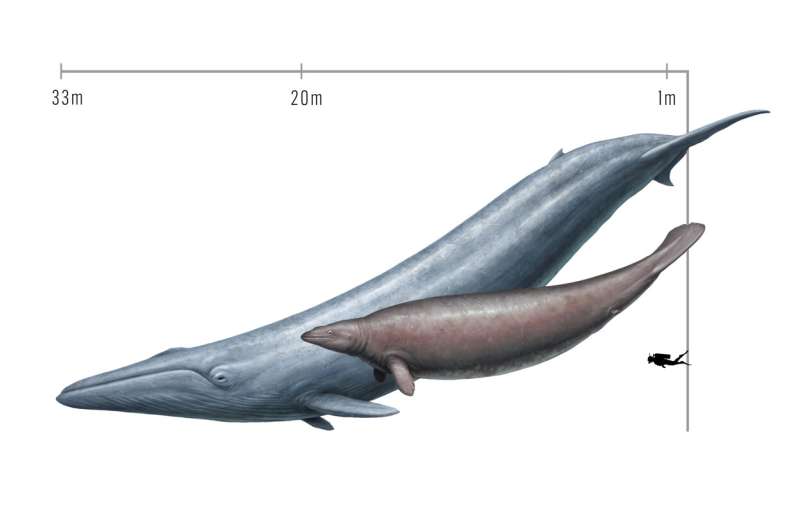This article has been reviewed according to Science X's editorial process and policies. Editors have highlighted the following attributes while ensuring the content's credibility:
fact-checked
trusted source
proofread
Slimming down a colossal fossil whale

A 30 million year-old fossil whale may not be the heaviest animal of all time after all, according to a new analysis by paleontologists at UC Davis and the Smithsonian Institution. The new analysis puts Perucetus colossus back in the same weight range as modern whales and smaller than the largest blue whales ever recorded. The work is published Feb. 29 in PeerJ.
A fossil skeleton of Perucetus was discovered in Peru and described in a paper in Nature in 2023. The animal lived about 39 million years ago and belonged to an extinct group of early whales called the basilosaurids.
Perucetus' bones are unusually dense. Mammal bones usually have a solid exterior and are spongy or hollow in the center. Some animals have more of the center filled in with solid bone, making them dense and heavy. In aquatic animals, heavy bones can offset buoyancy from body fat and blubber, allowing the animal to maintain neutral buoyancy in water or—in the case of the hippopotamus—to walk on river beds.
The fossil whale bones have both extensive in-filling and extra growth of bone on the outside as well, a condition called pachyostosis also seen in some modern aquatic mammals, such as manatees.
Based on a series of assumptions, the original authors (Giovanni Bianucci at the University of Pisa, Italy and colleagues) estimated a body mass for Perucetus of 180 metric tons (ranging from 85 to 340 metric tons). This would make Perucetus as heavy as, or heavier than the biggest blue whales known, even though it is considerably shorter at 17 meters long compared to a blue whale at about 30 meters.
How to weigh a whale?
Professor Ryosuke Motani, a paleobiologist at the UC Davis Department of Earth and Planetary Sciences, said that these estimates would make Perucetus impossibly dense.
"It would have been a job for the whale to stay at the surface, or even to leave the sea bottom—it would have required continuous swimming against the gravity to do anything in the water," Motani said.
Motani and Nick Pyenson at the Smithsonian Institute National Museum of Natural History reexamined the assumptions used to make those estimates.
The first problem is that Bianucci and team used the fossil bones to estimate the weight of the skeleton, then extrapolated to the weight of the entire animal, assuming that the skeletal and non-skeletal mass would scale at the same rate with increasing body size. But measurements of other animals show this is not the case, Motani and Pyenson argue.
The original estimates also overestimated how much overall body mass increases as a result of pachyostosis. But evidence from manatees shows that their bodies are relatively light relative to their skeletal mass.
Motani and Pyenson estimate that the 17-meter long Perucetus weighed in at 60 to 70 tons, considerably less than the known weights of blue whales. A Perucetus that grew to 20 meters could weigh over 110 tons, still well short of the largest blue whales at 270 tons.
"The new weight allows the whale to come to the surface and stay there while breathing and recovering from a dive, like most whales do," Motani said.
Paleontologists have not yet uncovered a skull or teeth of Perucetus, so it is hard to tell what it ate. Sustaining a huge body takes a lot of food. Bianucci and others suggested that Perucetus might have browsed on coastal fish and shellfish, or scavenged carcasses, as some sharks do. The new slimmed-down size estimate puts Perucetus in a similar range to sperm whales (80 tons, 20 meters long), which hunt large prey such as giant squid.
More information: Downsizing a heavyweight: factors and methods that revise weight estimates of the giant fossil whale Perucetus colossus, PeerJ (2024). DOI: 10.7717/peerj.16978
Provided by UC Davis




















